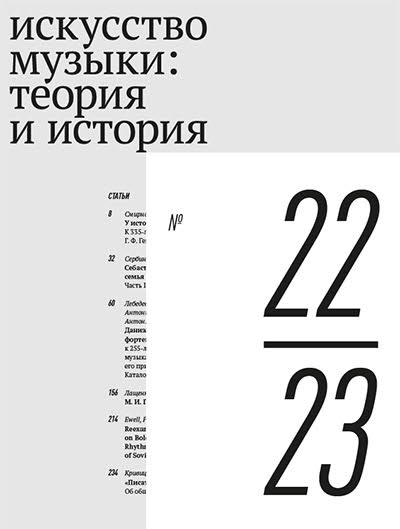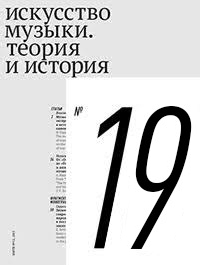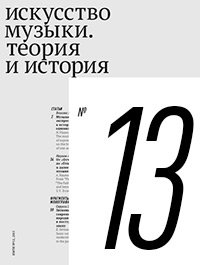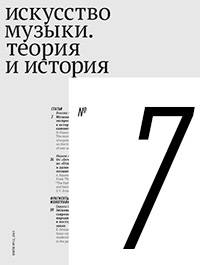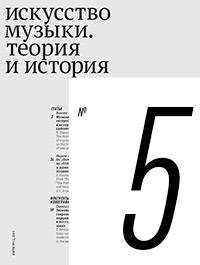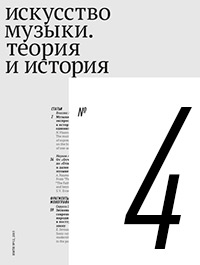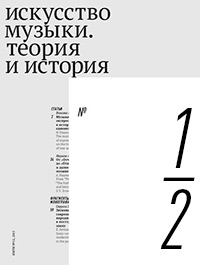2020 №№ 1-2
Articles
The Early Days of Russian Handeliana Celebrating the 335th Anniversary of G. F. Handel’s Birth
The article summarizes the available information related to the early Russian sources concerning G.F. Handel’s life and music. The evolution of those sources is described, from the earliest (beginning with the mid-18th century) brief sketches found in the letters of diplomats and travelers, anecdotes and short articles translated from European languages, to the detailed biographical essays on Handel published in specialized editions in the mid-19th century.
Sebastian George (Father) And His Family Part I. Biographical Essay
The article is dedicated to the work of the German composer Sebastian George, who was active in Moscow and Saint Petersburg in the 1760–90s. Not numerous available biographical data have been scrupulously assembled, verified and systematized. Several dozens instrumental pieces by George have been discovered; the next part of the publication on George will contain a complete catalogue of his works and an analytical essay on his extant pieces.
Daniel Steibelt and his Piano Works: to the 255Th Anniversary of His Birth and the 210th Anniversary of His Arrival in Saint Petersburg. A Catalogue of His Piano Music
This is the first catalogue of the piano music by the composer and pianist Daniel Steibelt (1765–1823). It includes all the works, the information on which have been found in the libraries and archives of Moscow and Saint Petersburg, as well as in the major international databases (International Music Score Library Project and Répertoire International des Sources Musicales). For a number of works their incipits are provided. The biographical information on the composer is presented; the opinions of his contemporaries on his art are quoted; the peculiarities of his musical style are described.
M. I. Glinka and E. F. Rosen
This is the first attempt to describe in detail the history of the collaboration between M. I. Glinka and E. F. Rosen – the co-authors of the opera A Life for the Tsar. The circumstances of their acquaintance are restored; the difficulties that arose during their work on the opera are discussed. Rosen’s aesthetic principles are characterized; the reasons behind his artistic decisions are analyzed. The collected and analyzed materials provide sufficient evidence to reconsider the myth about Glinka’s dissatisfaction with the work of his librettist, as well as to assess the role of their contemporaries and followers in the popularization of this myth. The article is supplemented by Rosen’s letter to the editors of the newspaper Severnaya Pchela (‘The Northern Bee’) defending his rights as the author of the opera’s literary text.
Reexamining the 1930 Conference on Boleslav Yavorsky’s Ladovy Rhythm and the Early Politics of Soviet Music Theory
In February 1930, the People’s Commissariat for Education in the Soviet Union convened a conference in Moscow on Boleslav Yavorsky’s theory of music, the “theory of ladovy rhythm.” The conference stands out as an example of how Marxist theory struggled to take hold not just in musicology, but in the arts generally. Very little musicological work on this conference has appeared in English, or in Russian for that matter. Gordon McQuere and Ellon Carpenter have both written about the conference in English, while various Soviet edited volumes also discuss the conference to an extent. None, however, examine the “Zaklyuchitel’noye slovo” (Closing remarks) from Yavorsky’s final speech at the conference itself. In this article I take these remarks into account. To a large extent, Yavorsky was pushing back against an encroaching Riemannian harmonic functionalism, which was represented in Russia by Georgy Catoire. Notably, the pedagogical aspect of the conference, namely, the publication of Sergei Protopopov’s Elementï stroyeniya muzïkal’noy rechi (Elements of the structure of music speech), was a key motivator for Yavorsky’s efforts. In this article I try to come to a better understanding of what this conference was about, and how the surrounding politics shaped early Soviet music theory.
‘Writing Letters Is a Very Important Affair’. On Leonid Kogan’s Connections with Contemporary Composers (On the Basis of the Materials from His Family Archive)
The article deals with the creative contacts of the outstanding Soviet violinist, People’s Artist of the USSR Leonid Kogan (1924–1982) with contemporary composers. The exclusive content includes details of their conversations, based on extant letters from the family archive and published memoirs; it shows the variety of Kogan’s artistic interests and his importance as an interpreter of modern music. A number of letters are published for the first time.
Incompatible Interpretations of Operatic Realism: Rockwell Kent and the Kirov Theater’s Production of Peter Grimes
In 1965, the Kirov Theater gave the Soviet premiere of Benjamin Britten’s Peter Grimes, Op. 33 – an opera depicting the psychological struggle of the title character, a poor fisherman who was alienated by the denizens of his seaside English village. To create the set designs for this piece, the directors of the Kirov Theater invited the American artist Rockwell Kent to submit sketches to the theater to serve as the basis for the production’s scenery. Kent had been shunned from American cultural life due to his political beliefs during the early Cold War, and had since sent his works to be exhibited in the Soviet Union. As a self-pronounced realist and socialist, whose illustrations for the 1930 edition of the classic novel Moby Dick were republished in the USSR in 1961, Kent seemed to be the perfect choice to design the sets for the Kirov production of Peter Grimes.
However, differences arose between Kent’s and scenery director Margarita Slutskaya’s conceptions of operatic realism. He dedicated himself to researching the historical appearance of nineteenth-century Aldeburgh and creating an accurate depiction of the town. Slutskaya, however, was interested in psychological realism: to truthfully present the subjective experience of the doomed fisherman in a town that despised him. Kent’s Moby Dick illustrations and his political art from the 1930s to the early 1950s were evocative and stylized, while his more recent work spurred these elements and concentrated predominately on landscapes. It was clear that Slutskaya favored the younger Kent, and considered his attempts at historical objectivity to be wholly inappropriate for her vision of the work: the immersion of the audience in Peter’s inner struggle and his conflict against the Borough. It is evident in their correspondence, which is preserved in the Central State Archives of Literature and Art in St. Petersburg, that the irreconcilable aesthetic differences between Kent’s literal and Slutskaya’s psychological interpretations of realism led to the collaboration’s untimely collapse and resulted in a production that arguably fell short of both of their ideals.
However, differences arose between Kent’s and scenery director Margarita Slutskaya’s conceptions of operatic realism. He dedicated himself to researching the historical appearance of nineteenth-century Aldeburgh and creating an accurate depiction of the town. Slutskaya, however, was interested in psychological realism: to truthfully present the subjective experience of the doomed fisherman in a town that despised him. Kent’s Moby Dick illustrations and his political art from the 1930s to the early 1950s were evocative and stylized, while his more recent work spurred these elements and concentrated predominately on landscapes. It was clear that Slutskaya favored the younger Kent, and considered his attempts at historical objectivity to be wholly inappropriate for her vision of the work: the immersion of the audience in Peter’s inner struggle and his conflict against the Borough. It is evident in their correspondence, which is preserved in the Central State Archives of Literature and Art in St. Petersburg, that the irreconcilable aesthetic differences between Kent’s literal and Slutskaya’s psychological interpretations of realism led to the collaboration’s untimely collapse and resulted in a production that arguably fell short of both of their ideals.
Excerpts From Books In Progress
Case Study: Poland
The present text is an excerpt from the work in progress, provisionally entitled The Third Quarter of the Century: The Flowering and Fading of the New Music. The general idea is to draw a large-scale panorama of music and musical life of the third quarter of the 20th century – a period that can be defined as the ‘axis time’ in the recent history of Western art music. One of the parts of the future monograph will be structured as a collection of case studies dealing with aspects of music, musical life and cultural politics in the countries that were especially productive in terms of art music. Such countries include Poland, where the compulsory orientation towards the aesthetic doctrine of Stalin’s USSR gave way in the mid-1950s to the policy of direct encouragement of ‘modernist’ experiments in art. One of the most important outcomes of the post-Stalin ‘thaw’ was the foundation of ‘Warsaw Autumn’ – the first contemporary music festival in Eastern Europe. The restored contacts with the West not only stimulated avant-garde tendencies among the musical youth (during the very first festivals a number of remarkable ‘radicals’ rose to prominence, who had to become central figures of Polish music), but also prompted some established masters to revise their stylistic orientation. In the present chapter, the oeuvre of the leading Polish composers who were active during the period in question is examined with due attention to their most important works.
Research Databases
Writing On Music In Russian Diaspora: Annotated Catalogue of Articles Published in RussianLanguage Press of the Late 1910s and the First Half of the 1920s.
The present publication of the catalogue of materials from the Russian-language Berlin newspaper Rul’ (‘Rudder’) of January–March 1925 continues the project ‘Writing on Music in Russian Diaspora: an Annotated Catalogue of Articles Published by Russian-Language Press Abroad’.









